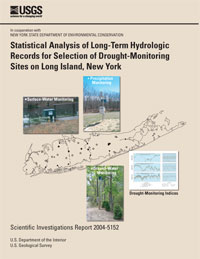Statistical analysis of long-term hydrologic records for selection of drought-monitoring sites on Long Island, New York
Links
- Document: Report (6.69 MB pdf)
- Download citation as: RIS | Dublin Core
Abstract
Ground water is the sole source of water supply for more than 3 million people on Long Island, New York. Large-scale ground-water pumpage, sewering systems, and prolonged periods of below-normal precipitation have lowered ground-water levels and decreased stream-discharge in western and central Long Island. No method is currently (2004) available on Long Island that can assess data from the ground-water-monitoring network to enable water managers and suppliers with the ability to give timely warning of severe water-level declines.
This report (1) quantifies past drought- and human-induced changes in the ground-water system underlying Long Island by applying statistical and graphical methods to precipitation, stream-discharge, and ground-water-level data from selected monitoring sites; (2) evaluates the relation between water levels in the upper glacial aquifer and those in the underlying Magothy aquifer; (3) defines trends in stream discharge and ground-water levels that might indicate the onset of drought conditions or the effects of excessive pumping; and (4) discusses the long-term records that were used to select sites for a Long Island drought-monitoring network.
Long Island’s long-term hydrologic records indicated that the available data provide a basis for development of a drought-monitoring network. The data from 36 stations that were selected as possible drought-monitoring sites—8 precipitation-monitoring stations, 8 streamflow-gaging (discharge) stations, 15 monitoring wells screened in the upper glacial aquifer under water-table (unconfined) conditions, and 5 monitoring wells screened in the underlying Magothy aquifer under semi-confined conditions—indicate that water levels in western parts of Long Island have fallen and risen markedly (more than 15 ft) in response to fluctuations in pumpage, and have declined from the increased use of sanitary- and storm-sewer systems. Water levels in the central and eastern parts, in contrast, remain relatively unaffected compared to the western parts, although the effects of human activity are discernible in the records.
The value of each site as a drought-monitoring indicator was assessed through an analysis of trends in the records. Fifty-year annual and monthly data sets were created and combined into three composite-average hydrographs—precipitation, stream discharge, and ground-water levels. Three zones representing the range of human effect on ground-water levels were delineated to help evaluate islandwide hydrologic conditions and to quantify the indices. Data from the three indices can be used to assess current conditions in the ground-water system underlying Long Island and evaluate water-level declines during periods of drought.
Suggested Citation
Busciolano, R.J., 2005, Statistical analysis of long-term hydrologic records for selection of drought-monitoring sites on Long Island, New York: U.S. Geological Survey Scientific Investigations Report 2004-5152, v, 47 p., https://doi.org/10.3133/sir20045152.
ISSN: 2328-0328 (online)
Table of Contents
- Abstract
- Introduction
- Purpose and Scope
- Hydrogeology and effects of human activity (pumping and sewers)
- Statistical Analysis of Long-Term Hydrologic Records
- Selection of Drought-Monitoring Sites
- Future Implementation of Drought-Monitoring Indices
- Summary and Conclusions
- Acknowledgments
- References Cited
| Publication type | Report |
|---|---|
| Publication Subtype | USGS Numbered Series |
| Title | Statistical analysis of long-term hydrologic records for selection of drought-monitoring sites on Long Island, New York |
| Series title | Scientific Investigations Report |
| Series number | 2004-5152 |
| DOI | 10.3133/sir20045152 |
| Year Published | 2005 |
| Language | English |
| Publisher | U.S. Geological Survey |
| Publisher location | Reston, VA |
| Contributing office(s) | New York Water Science Center |
| Description | v, 47 p. |
| Online Only (Y/N) | Y |
| Additional Online Files (Y/N) | N |


